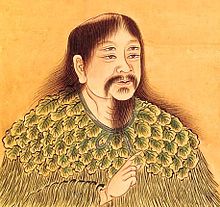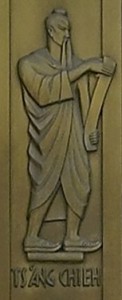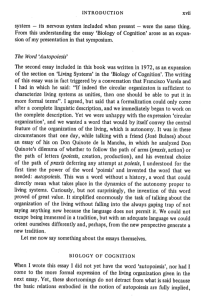傳說倉頡生有『雙瞳四目』是黃帝史官,創造文字,故稱之為『倉頡先師』。
《淮南子‧本經》中記載:昔者倉頡作書 ,而天雨粟,鬼夜哭。
《春秋元命苞》裡講︰龍顏侈侈,四目靈光 ,實有睿德,生而能書。於是窮天地之變 ,仰觀奎星圓曲之勢,俯察龜文鳥羽山川,指掌而創文字,天為雨粟,鬼為夜哭,龍乃潛藏。
唐朝知名的國畫歷史家之祖,張彥遠之《歷代名畫記‧敘畫之源流》解釋說: 頡有四目,仰觀天象。因儷烏龜之跡,遂定書字之形。造化不能藏其秘,故天雨粟;靈怪不能 遁其形,故鬼夜哭。是時也,書畫同體而未分,象制肇創而猶略。無以傳其意故有書,無以見其形故有畫,天地聖人之意也。
『字』 『詞』是『符號』,承載『概念』,界定『事物』,具有『意義』。然而由於『字』『詞』的『意指』可能發生『含混』與『歧義』,或為『複雜錯綜』的萬象之 『命名』和『化約』描寫,也許正是『造新字』之時!其『大』者,一『字』竟然可以開拓『新視野』,創生多門『學術領域』!!
Autopoiesis 正是這樣的一個字詞。
出自《 Autopoiesis and Cognition: the Realization of the Living 》一文, WiKi Autopoiesis 詞條,將之整理為︰
The original definition can be found in Autopoiesis and Cognition: the Realization of the Living (1st edition 1973, 2nd 1980):
Page xvii: – It was in these circumstances…in which he analyzed Don Quixote’s dilemma 【唐吉訶德二難】of whether to follow the path of arms (praxis, action) or the path of letters (poiesis, creation, production), I understood for the first time the power of the word ‘poiesis‘ and invented the word that we needed: autopoiesis. This was a word without a history, a word that could directly mean what takes place in the dynamics of the autonomy 【自主性】 proper to living systems.
Page 78: – An autopoietic machine is a machine organized (defined as a unity) 【整體】 as a network of processes of production (transformation and destruction) of components which: (i) through their interactions and transformations continuously regenerate 【再生】and realize 【實現】 the network of processes (relations) that produced them; and (ii) constitute 【組構】it (the machine) as a concrete unity in space in which they (the components) exist by specifying the topological domain of its realization as such a network.
Page 89:– […] the space defined by an autopoietic system is self-contained and cannot be described by using dimensions that define another space. When we refer to our interactions with a concrete autopoietic system, however, we project this system on the space of our manipulations and make a description of this projection.
這是智利神經生理學家亨伯特‧馬圖拉那 Humberto Maturana 與其學生著名的認知科學家弗朗西斯科‧瓦雷拉 Francisco Varela 師徒二人合著的一篇大作。為著界定
生命是什麼?所創造的『字』。
─── 摘自《M♪o 之 TinyIoT ︰ 《起合》※補充一︰造字》
『Autopoiesis』這個『字』,中文翻譯為『自我生成』,縱考之以『幽默大師』之『信、雅、達』境界之旨,尚且得宜乎??
據聞『幽默大師』林語堂,曾在《晨報》副刊上寫文章將英文的『 humour 』這個字詞半音半譯作了『幽默』。 WiKi 上講︰
Humour or humor (see spelling differences) is the tendency of particular cognitive experiences to provoke laughter and provide amusement. The term derives from the humoral medicine of the ancient Greeks, which taught that the balance of fluids in the human body, known as humours (Latin: humor, “body fluid”), controlled human health and emotion.
這個意義詮釋可謂巧妙,音近意遠,英文分明是『惹‧搞』笑,但是當用著『幽靜‧靜默』,中英對照中,恍然大悟『噗哧‧莞爾』皆宜,果真是『不偷自得』之笑的耶!然而那『化鬚』之『疏』的『幽默』之旨,卻是笑的『鉤沈』!!
─── 摘自《樹莓派之幽默‧跳針?!》
雖說科技變遷快速,重要『概念觀點』還是值得細嚼慢嚥再歸結成『詞』好耶!!
如此『holography』
The word holography comes from the Greek words ὅλος (holos; “whole”) and γραφή (graphē; “writing” or “drawing“).
翻成『全』『像』豈不理所當然?如譯作『全』『息』果真就沒有理據!或當仿效『週期表』之法,另創造『新字』??
總覺過猶不及哩!!
假使用『瀏覽現有字詞』能『聯想使用科技』為觀點,
『全像顯示【器】』
Holographic display
A holographic display is a type of display that utilizes light diffraction to create a virtual three-dimensional image of an object. Holographic displays are unique from other forms of 3D imaging in that they do not require the aid of any special glasses or external equipment for a viewer to see the image.
也許優於
『全息屏幕』
Holographic screen
A holographic screen is a two dimensional display technology that uses coated glass media for the projection surface of a video projector. “Holographic” refers not to a stereoscopic effect (for that, see Holographic display), but to the coating that bundles light using formed microlenses. The lens design and attributes match the holographic area. The lenses may appear similar to the fresnel lenses used in overhead projectors. The resulting effect is that of a free-space display, because the image carrier appears very transparent. Additionally, the beam manipulation by the lenses can be used to make the image appear to be floating in front of or behind the glass, rather than directly on it. However, this display is only two-dimensional and not true three-dimensional. It is unclear if such a technology will be able to provide acceptable three-dimensional images in the future.
Working principle
The display design can use either front or rear projection, in which one or more video projectors are directed at the glass plate. Each projector’s beam widens as it approaches the surface and then is bundled again by the lenses’ arrangement on the glass. This forms a virtual point of origin, so that the image source appears to be an imaginary object somewhere close to the glass. In rear projection (the common use case), the light passes through the glass; in front projection it is reflected.

Basic scheme of interactive holographic screens
於是有人將之翻譯成『浮空投影布幕』。
推敲那個『浮空投影』
| 國立台中教育大學 NTCU
科學教育與應用學系 |
科學遊戲實驗室 回首頁 |
浮空投影
| 如何讓影像漂浮在空中呢? |
| ※器材:手機或平板電腦、透明膠片(厚度0.25mm)、美工刀、膠帶 |
| ※操作步驟與現象: |
| 這 個實驗是版主在YouTube看到的影片,利用手機或平板電腦,可以將影像投影浮在空中。如圖一,手機下載的影片,可以播放出上下左右共四個影像的動態影 片。放上一個立體梯形的透明片(如圖二),就可以看到浮在空中的動態影像了。將燈光關掉或是在暗室中(如圖三),動態影像就更為清楚了! |

當下英文常指『Holographic Projection』,實講光線因『反射』或『折射』所引發之『海市蜃樓』現象,並非與『全像的』 □ □ 明顯相干,因此不應翻成『全像投影』吧??
所以叫做『浮空投影』又有何不可呢!!
※ 探索者之參考資料◎
Pellicle mirror
A pellicle mirror (diminutive of pellis, a skin or film) is an ultra-thin, ultra-lightweight semi-transparent mirror employed in the light path of an optical instrument, splitting the light beam into two separate beams, both of reduced light intensity. Splitting the beam allows its use for multiple purposes simultaneously. The thinness of the mirror practically eliminates beam or image doubling due to a non-coincident weak second reflection from the nominally non-reflecting surface, a problem with mirror-type beam splitters.[1]

The pellicle mirror of the Canon EOS RT
Pepper’s ghost
Pepper’s ghost is an illusion technique used in theatre, amusement parks, museums, television, and concerts. It is named after John Henry Pepper (1821–1900), a scientist who popularized the effect in a demonstration in 1862.[1] Examples of the illusion are the Girl-to-Gorilla trick found in old carnival sideshows and the appearance of “Ghosts” at the Haunted Mansion and the “Blue Fairy” in Pinocchio’s Daring Journey at the Disneyland park in California. Teleprompters are a modern implementation of Pepper’s ghost. The technique was used for the appearance of Tupac Shakur onstage with Dr. Dre and Snoop Dogg at the 2012 Coachella Music and Arts Festival and Michael Jackson at the 2014 Billboard Music Awards.

A viewer looking through the red rectangle sees a ghost floating next to the table. The illusion is produced by a large piece of glass, Plexiglas or plastic film situated at an angle between viewer and scene (green outline). The glass reflects a room hidden from the viewer (left), sometimes called a “blue room”, that is built as mirror-image of the scene.
 If the mirror-image room (left) is darkened, it does not reflect well in the glass. The empty room (top) is brightly lit, making it very visible to the viewer.
If the mirror-image room (left) is darkened, it does not reflect well in the glass. The empty room (top) is brightly lit, making it very visible to the viewer.

When the lights in the mirror-image room are raised (with the empty room being dimmed slightly to compensate), the ghost appears out of nowhere.


